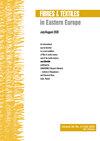低分子量酯类结构对聚乳酸塑化过程的影响——第一部分
IF 0.9
4区 工程技术
Q3 MATERIALS SCIENCE, TEXTILES
引用次数: 1
摘要
摘要来源于可再生资源的聚合物还需要经过降解过程,目前是石化来源的传统聚合物的一种有趣的替代品。其中一种聚合物是聚乳酸(PLA),可用于包装、纺织和医疗行业。它的最大优点是易于生物降解,降解产物无毒。由于PLA具有较高的脆性和刚度,因此有必要对其进行改性,以提高其塑性变形能力,从而拓展其新的应用可能性。作为研究工作的一部分,对聚乳酸进行了塑化改性,以提高其塑性变形性能。使用来自柠檬酸基团的低分子量酯和甘油三乙酸酯。使用差示扫描量热法(DSC)和凝胶渗透色谱法/尺寸排阻色谱法(GPC/SEC)对由塑化聚合物挤出的样品进行表征。测定了改性后的力学性能和熔体流动速率。研究的目的是确定增塑剂的结构与其减少聚合物链中相互作用的能力之间的关系,以开发最佳的聚合物增塑剂排列。基于这项研究,增塑过程的效率与增塑剂分子量的增加之间没有关系。增塑剂中的额外化学基团(乙酰基)也不会增加PLA增塑过程的效率。在下一步的研究中,将从选定的聚合物增塑剂系统中生产功能形式,即纤维、薄膜和配件。本文章由计算机程序翻译,如有差异,请以英文原文为准。
Influence of the Structure of Low MolecularWeight Esters on Poly(lactic acid) in the Plasticization Process - part 1
Abstract Polymers derived from renewable sources which are additionally subject to degradation processes are currently an interesting alternative to conventional polymers of petrochemical origin. One of such polymers is poly(lactic acid) (PLA), which can be used in the packaging, textile and also medical industries. Its great advantage is the susceptibility to biodegradation and the nontoxicity of the degradation products. Because of high brittleness and stiffness, the modification of PLA is necessary to improve its plastic deformability, which can expand the new application possibilities. As part of the research work, the modification of PLA by plasticisation was undertaken to improve its plastic deformability properties. The low molecular mass esters from the citrate group and glycerol triacetate were used. The samples extruded from plasticised polymer were characterised using Differential Scanning Calorimetry (DSC) and Gel Permeation Chromatography/Size Exclusion Chromatography (GPC/SEC). The mechanical properties and melt flow rate after modification were determined. The aim of the research was to determine the relationship between the structure of a plasticiser and its ability to reduce the interactions in the polymer chain in order to develop an optimal polymer-plasticiser arrangement. Based on this research, there was no relationship between the efficiency of the plasticisation process and the increasing molecular mass of the plasticiser. The additional chemical (acetyl) group in the plasticiser also does not increase the efficiency of the PLA plasticisation process. In the next steps of the research, functional forms will be produced, i.e. fibers, films, and fittings from the selected polymer-plasticiser systems.
求助全文
通过发布文献求助,成功后即可免费获取论文全文。
去求助
来源期刊

Fibres & Textiles in Eastern Europe
工程技术-材料科学:纺织
CiteScore
1.60
自引率
11.10%
发文量
12
审稿时长
13.5 months
期刊介绍:
FIBRES & TEXTILES in Eastern Europe is a peer reviewed bimonthly scientific journal devoted to current problems of fibre, textile and fibrous products’ science as well as general economic problems of textile industry worldwide. The content of the journal is available online as free open access.
FIBRES & TEXTILES in Eastern Europe constitutes a forum for the exchange of information and the establishment of mutual contact for cooperation between scientific centres, as well as between science and industry.
 求助内容:
求助内容: 应助结果提醒方式:
应助结果提醒方式:


